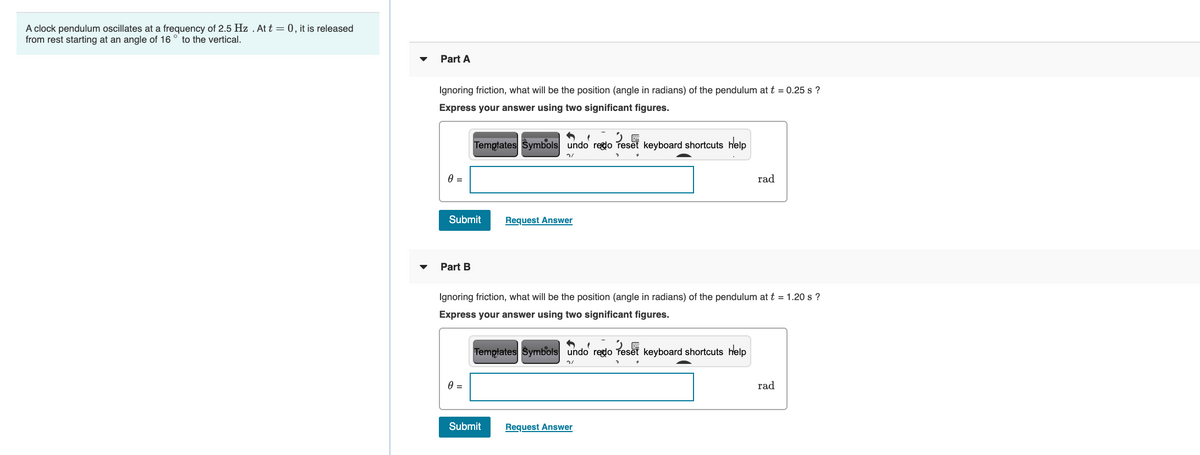A clock pendulum oscillates at a frequency of 2.5 Hz . Att = 0, it is released from rest starting at an angle of 16° to the vertical. Part A Ignoring friction, what will be the position (angle in radians) of the pendulum at t = 0.25 s ? Express your answer using two significant figures. Temgtates Symbols undo rego Teset keyboard shortcuts help rad Submit Request Answer Part B Ignoring friction, what will be the position (angle in radians) of the pendulum at t = 1.20s? Express your answer using two significant figures. Templates Symbols undo redo Teset keyboard shortcuts help rad
A clock pendulum oscillates at a frequency of 2.5 Hz . Att = 0, it is released from rest starting at an angle of 16° to the vertical. Part A Ignoring friction, what will be the position (angle in radians) of the pendulum at t = 0.25 s ? Express your answer using two significant figures. Temgtates Symbols undo rego Teset keyboard shortcuts help rad Submit Request Answer Part B Ignoring friction, what will be the position (angle in radians) of the pendulum at t = 1.20s? Express your answer using two significant figures. Templates Symbols undo redo Teset keyboard shortcuts help rad
Principles of Physics: A Calculus-Based Text
5th Edition
ISBN:9781133104261
Author:Raymond A. Serway, John W. Jewett
Publisher:Raymond A. Serway, John W. Jewett
Chapter12: Oscillatory Motion
Section: Chapter Questions
Problem 11OQ
Related questions
Question
Can i get help with these questions

Transcribed Image Text:A clock pendulum oscillates at a frequency of 2.5 Hz . At t = 0, it is released
from rest starting at an angle of 16 ° to the vertical.
Part A
Ignoring friction, what will be the position (angle in radians) of the pendulum at t = 0.25 s ?
Express your answer using two significant figures.
Temptates Symbols undo redo reset keyboard shortcuts help
rad
Submit
Request Answer
Part B
Ignoring friction, what will be the position (angle in radians) of the pendulum at t = 1.20 s ?
Express your answer using two significant figures.
Templates Symbols undo redo Teset keyboard shortcuts help
rad
Submit
Request Answer
Expert Solution
This question has been solved!
Explore an expertly crafted, step-by-step solution for a thorough understanding of key concepts.
This is a popular solution!
Trending now
This is a popular solution!
Step by step
Solved in 2 steps

Knowledge Booster
Learn more about
Need a deep-dive on the concept behind this application? Look no further. Learn more about this topic, physics and related others by exploring similar questions and additional content below.Recommended textbooks for you

Principles of Physics: A Calculus-Based Text
Physics
ISBN:
9781133104261
Author:
Raymond A. Serway, John W. Jewett
Publisher:
Cengage Learning

University Physics Volume 1
Physics
ISBN:
9781938168277
Author:
William Moebs, Samuel J. Ling, Jeff Sanny
Publisher:
OpenStax - Rice University

Physics for Scientists and Engineers, Technology …
Physics
ISBN:
9781305116399
Author:
Raymond A. Serway, John W. Jewett
Publisher:
Cengage Learning

Principles of Physics: A Calculus-Based Text
Physics
ISBN:
9781133104261
Author:
Raymond A. Serway, John W. Jewett
Publisher:
Cengage Learning

University Physics Volume 1
Physics
ISBN:
9781938168277
Author:
William Moebs, Samuel J. Ling, Jeff Sanny
Publisher:
OpenStax - Rice University

Physics for Scientists and Engineers, Technology …
Physics
ISBN:
9781305116399
Author:
Raymond A. Serway, John W. Jewett
Publisher:
Cengage Learning

Classical Dynamics of Particles and Systems
Physics
ISBN:
9780534408961
Author:
Stephen T. Thornton, Jerry B. Marion
Publisher:
Cengage Learning

Physics for Scientists and Engineers: Foundations…
Physics
ISBN:
9781133939146
Author:
Katz, Debora M.
Publisher:
Cengage Learning

Glencoe Physics: Principles and Problems, Student…
Physics
ISBN:
9780078807213
Author:
Paul W. Zitzewitz
Publisher:
Glencoe/McGraw-Hill